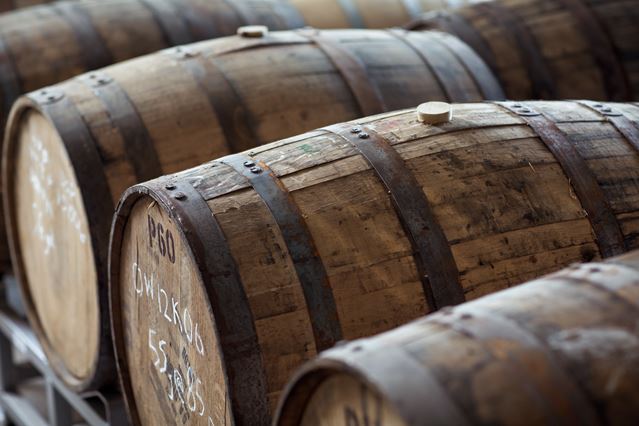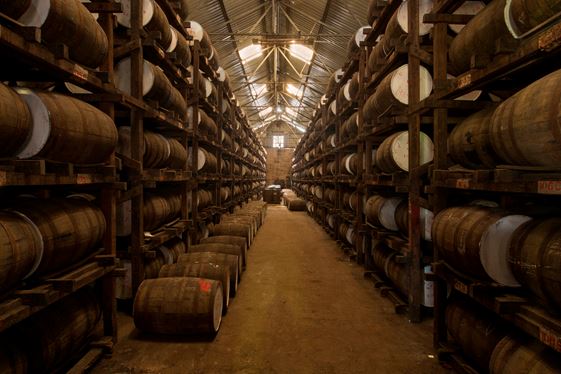
By fermenting and distilling molasses, these planters created a potentially profitable new commodity. But to really make money from their spirits they needed to bring them to a global market, and barrels and puncheons were originally just a way of getting them from A to B. The Jamaican and Bajan rums that filled London’s punch bowls in the 18th century were filled into cask at origin, shipped across the Atlantic, and warehoused by the docks before consumption. On their journey from sugar factories in the tropics to cellars in the decidedly un-tropical south of England, these spirits experienced a wide variety of atmospheric conditions. When they saw the light of day again, they were dark in colour and richly flavoured. During each part of the journey, variations in temperature and humidity had affected the way the rums interacted with the staves, altering their character completely.
Today, some rums are sold with the proud claim that they are tropically aged, meaning they’ve been matured entirely at their place of origin. Bottlers also offer continentally aged rums that have spent some or all of their lives in cooler European climes, which alters the character of the finished article enormously. If you were to take two casks filled in Guyana on the same day and leave one at the distillery and ship the other to Europe, then in a few short years you would have two quite different rums on your hands.
The first thing you would notice is that the tropically-aged example would be a deeper colour and show more of the aromas associated with oak: vanilla, nuts, and general spiciness, for example. But what Paul McFadyen, rum educator and brand manager for Plantation, is quick to point out, is that there’s more to maturation than just oak. “If you put rum into a barrel, the wood will give something to it, that’s obviously a very important part of ageing. But it’s only one of myriad reactions that happen during the process. The one that’s really key is oxidative reduction, oxygen coming through the pores of the wood and catalysing numerous other reactions inside the barrel.” By changing the maturation climate, therefore, you not only change the rate of the reaction with the oak but also change the effect as well as the rate of the other reactions taking place.
Plantation – the rum label operated by Cognac house Maison Ferrand – purchases casks from various sources around the Caribbean and beyond, selecting rums that have already benefited from a little tropical ageing. These casks are then shipped to France where they are further matured in cool cellars like those used to produce Cognac. “In the past, rum companies would often say that aging in the Caribbean was three times faster than in a temperate climate. Meaning a ten-year-old rum would be equivalent to a 30-year-old whisky. And there’s some truth to that – you strip tannins and other compounds out of the wood much more readily in the 30 year-round head of Barbados than you do in the 17-degree – if you’re lucky – temperatures in southwest France. But there’s no shortcut for oxidative reduction, there’s just no way to speed up that process.” By aging casks of rum in relatively cool conditions – In Scotland or France, for instance – you slow down the rate of extraction from the oak. As a result, this process of oxidative reduction can continue long past the point where the spirit might otherwise have become over-extracted and unpalatably tannic. “None of this is to say that ageing the Caribbean isn’t really magic, that intense heat contributes to what we think of as the terroir,” Paul cautions. But it’s clear that in moving rum around you open up possibilities.
Continental ageing isn’t just about extending ageing potential, however. By cultivating different atmospheric conditions in their warehouses, bottlers can encourage different flavour profiles in their rums. “Once we’re in France we make a number of different decisions. What kind of warehouse you put it in and where in the warehouse you put it will greatly impact how the liquid matures,” Paul tells us. “We have humid cellars and dry cellars. In the dry cellar you’ve got a concrete floor and a very low atmospheric humidity, which means you get a very balanced departure of the alcohol and the water from the barrel. In the humid cellar, there’s less pressure applied to the water so it evaporates slowly – but the alcohol level drops very readily.” By monitoring casks closely and moving them periodically, Plantation can create a range of flavour profiles that are invaluable to its blenders. It’s an approach traditionally used by the Cognac industry and one that would be harder to achieve in the tropics. The question we might be tempted to ask is, ‘are rums made in this way better?’
The argument against might be that the climate in the Caribbean is a part of rum’s essential character. That the same heat that allowed for the cultivation of cane should influence the spirit as it ages for a true reflection of terroir. Regulations surrounding other categories are very strict about aging at source, as the local climate is considered definitional to the style. If you took a cask of Speyside malt and flew it to Jamaica for further aging it would cease to be Scotch whisky and legally become a nationless spirit beverage. Should this same logic be applied to rum? Are casks matured in the place they were made somehow more authentic than those expatriated to the old world? For Paul, at least, it comes down to options and preference. “Rum is quite a broad church and there’s plenty of room for everyone to worship. The joy of rum is that no other category has such a diverse span of flavour profiles and choices. That’s what makes it so exciting. We’re just creating a different product. The responsibility for creating a pure, 100% Caribbean product is down to the original producers – that’s for them to do. Under the Plantation brand we do our processes and that’s our identity, that’s essentially how we add value to the production chain.”
Though the techniques employed by Plantation are elaborate, they do have precedent in the evolution of rum as a category. Think back to those casks aging by the docks on the Thames, or about the storied history of navy blends. Rum has always been an export commodity, and it’s always been shaped by the places it has travelled. Continental styles may drift away from their original terroir, but the journey gives them a character all their own.

